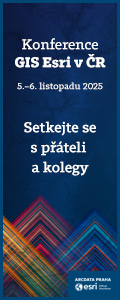ESA Navigation 
zdroje zpráv:
ESA leads drive into our 5G positioning future
1.10.2019 12:17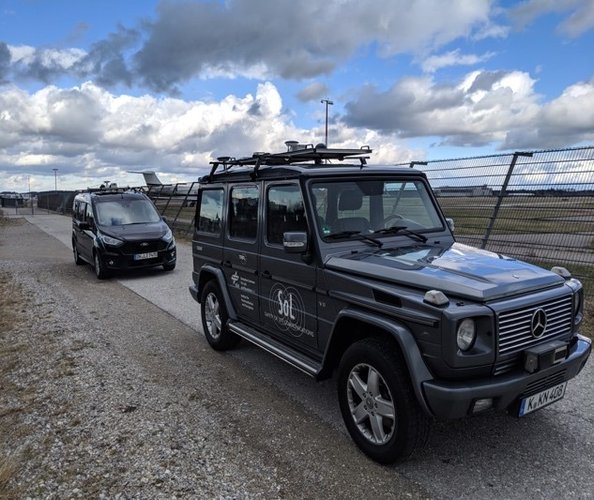
A pair of testbed vehicles went out on the road in Germany to simulate the way we are all likely to be using 5G positioning services in the future. The field test focused on assessing the performance of highly-precise ‘hybrid’ satellite/terrestrial positioning for autonomous vehicles, drones, smart cities and the Internet of Things.
ESA leads drive into our 5G positioning future
1.10.2019 12:17
A pair of testbed vehicles went out on the road in Germany to simulate the way we are all likely to be using 5G positioning services in the future. The field test focused on assessing the performance of highly-precise ‘hybrid’ satellite/terrestrial positioning for autonomous vehicles, drones, smart cities and the Internet of Things.
ESA leads drive into our 5G positioning future
1.10.2019 12:17
A pair of testbed vehicles went out on the road in Germany to simulate the way we are all likely to be using 5G positioning services in the future. The field test focused on assessing the performance of highly-precise ‘hybrid’ satellite/terrestrial positioning for autonomous vehicles, drones, smart cities and the Internet of Things.
Operation Shark Bait
24.9.2019 13:48
A volunteer set adrift on a life raft in the North Sea began a live demonstration of the ESA-designed Galileo search and rescue system. Rewatch live coverage here
Operation Shark Bait
24.9.2019 13:48
A volunteer set adrift on a life raft in the North Sea began a live demonstration of the ESA-designed Galileo search and rescue system. Rewatch live coverage here
Operation Shark Bait
24.9.2019 13:48
A volunteer set adrift on a life raft in the North Sea will start a live demonstration of the ESA-designed Galileo search and rescue system. Follow live from Ostend in Belgium from 13:10 CEST (11:15 UTC) this Thursday
Operation Shark Bait
24.9.2019 13:48
A volunteer set adrift on a life raft in the North Sea will start a live demonstration of the ESA-designed Galileo search and rescue system. Follow live from Ostend from 13:10 CEST (11:15 UTC) this Thursday
New maps of Earth from reflected satnav, invented at ESA
20.9.2019 8:48
Your phone or satnav receiver routinely picks up signals from navigation satellites in order to tell you precisely where you are. But have you ever thought what happens to those satnav signals afterwards? A foresighted ESA inventor had the idea of using them as a tool for observing the Earth.
New maps of Earth from reflected satnav, invented at ESA
20.9.2019 8:48
Your phone or satnav receiver routinely picks up signals from navigation satellites in order to tell you precisely where you are. But have you ever thought what happens to those satnav signals afterwards? A foresighted ESA inventor had the idea of using them as a tool for observing the Earth.
New maps of Earth from reflected satnav, invented at ESA
20.9.2019 8:48
Your phone or satnav receiver routinely picks up signals from navigation satellites in order to tell you precisely where you are. But have you ever thought what happens to those satnav signals afterwards? A foresighted ESA inventor had the idea of using them as a tool for observing the Earth.
New maps of Earth from reflected satnav, invented at ESA
20.9.2019 8:48
Your phone or satnav receiver routinely picks up signals from navigation satellites in order to tell you precisely where you are. But have you ever thought what happens to those satnav signals afterwards? A foresighted ESA inventor had the idea of using them as a tool for observing the Earth.
Galileo paper model
28.8.2019 15:01
Print out, cut out and assemble your own model of a Galileo navigation satellite
Galileo paper model
28.8.2019 15:01
Print out, cut out and assemble your own model of a Galileo navigation satellite
Satnav serving aircraft safely, thanks to augmentation systems
17.7.2019 9:26
Satellite navigation is useful in the air as well as on the land and sea. But stringent safety requirements mean the signals from space need to be supplemented using an additional system to be usable by the aviation sector. An international group of experts meets regularly to ensure such regional augmentation systems work together on a seamless basis.
Satnav serving aircraft safely, thanks to augmentation systems
17.7.2019 9:26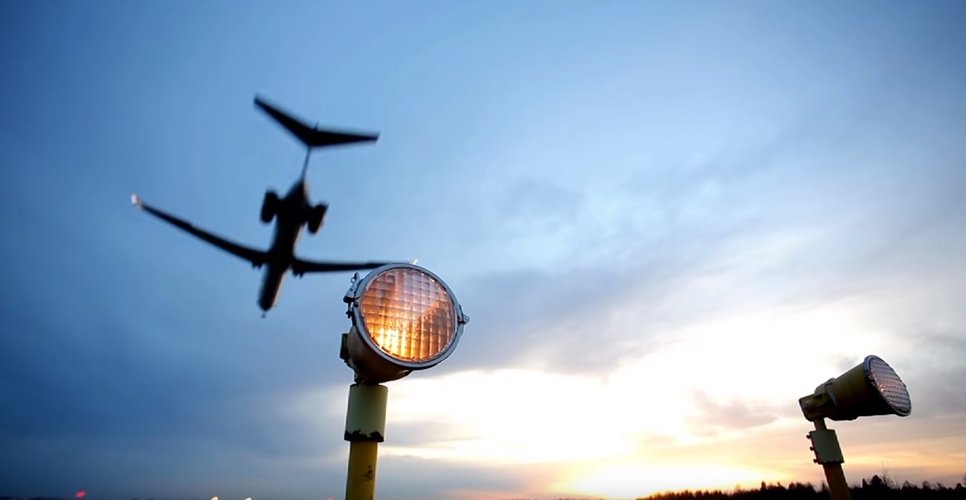
Satellite navigation is useful in the air as well as on the land and sea. But stringent safety requirements mean the signals from space need to be supplemented using an additional system to be usable by the aviation sector. An international group of experts meets regularly to ensure such regional augmentation systems work together on a seamless basis.
Satnav serving aircraft safely, thanks to augmentation systems
17.7.2019 9:26
Satellite navigation is useful in the air as well as on the land and sea. But stringent safety requirements mean the signals from space need to be supplemented using an additional system to be usable by the aviation sector. An international group of experts meets regularly to ensure such regional augmentation systems work together on a seamless basis.
Satnav serving aircraft safely, thanks to augmentation systems
17.7.2019 9:26
Satellite navigation is useful in the air as well as on the land and sea. But stringent safety requirements mean the signals from space need to be supplemented using an additional system to be usable by the aviation sector. An international group of experts meets regularly to ensure such regional augmentation systems work together on a seamless basis.
Vega Flight VV15 failure: Arianespace and ESA appoint an independent inquiry commission
11.7.2019 17:26
Galileo making its mark
1.7.2019 13:04
To test student-developed smartphone apps harnessing Galileo’s dual-frequency signals, engineers traced out ‘ESA GALILEO’ as accurately as possible across a football field
Galileo making its mark
1.7.2019 13:04
To test student-developed smartphone apps harnessing Galileo’s dual-frequency signals, engineers traced out ‘ESA GALILEO’ as accurately as possible across a football field
Galileo making its mark
1.7.2019 13:04
To test student-developed smartphone apps harnessing Galileo’s dual-frequency signals, engineers traced out ‘ESA GALILEO’ as accurately as possible across a football field
Galileo making its mark
1.7.2019 13:04
To test student-developed smartphone apps harnessing Galileo’s dual-frequency signals, engineers traced out ‘ESA GALILEO’ as accurately as possible across a football field
Dual-frequency smartphone app winners prove power of two
7.6.2019 14:16
Europe’s students and young researchers were challenged to design a smartphone app to take advantage of Galileo’s dual-frequency signal. The winning entries should soon be available to the public.
Dual-frequency smartphone app winners prove power of two
7.6.2019 14:16
Europe’s students and young researchers were challenged to design a smartphone app to take advantage of Galileo’s dual-frequency signals. The winning entries should soon be available to the public.
Dual-frequency smartphone app winners prove power of two
7.6.2019 14:16
Europe’s students and young researchers were challenged to design a smartphone app to take advantage of Galileo’s dual-frequency signals. The winning entries should soon be available to the public.
Dual-frequency smartphone app winners prove power of two
7.6.2019 14:16
Europe’s students and young researchers were challenged to design a smartphone app to take advantage of Galileo’s dual-frequency signals. The winning entries should soon be available to the public.
Dual-frequency smartphone app winners prove power of two
7.6.2019 14:16
Europe’s students and young researchers were challenged to design a smartphone app to take advantage of Galileo’s dual-frequency signals. The winning entries should soon be available to the public.
Dual-frequency smartphone app winners prove power of two
7.6.2019 14:16
Europe’s students and young researchers were challenged to design a smartphone app to take advantage of Galileo’s dual-frequency signals. The winning entries should soon be available to the public.
Smartphones plus satnav for safer, smarter festivals
27.5.2019 10:15
Summertime in Europe equals festivals: people gathered together for music and arts under an open sky. But the very popularity of these events can lead to problems. A new ESA-backed project makes use of smartphones – that essential festival accessory – to help reduce overcrowding, avoid overwhelmed facilities and keep friends together.
Smartphones plus satnav for safer, smarter festivals
27.5.2019 10:15
Summertime in Europe equals festivals: people gathered together for music and arts under an open sky. But the very popularity of these events can lead to problems. A new ESA-backed project makes use of smartphones – that essential festival accessory – to help reduce overcrowding, avoid overwhelmed facilities and keep friends together.
Smartphones plus satnav for safer, smarter festivals
27.5.2019 10:15
Summertime in Europe equals festivals: people gathered together for music and arts under an open sky. But the very popularity of these events can lead to problems. A new ESA-backed project makes use of smartphones – that essential festival accessory – to help reduce overcrowding, avoid overwhelmed facilities and keep friends together.
Smartphones plus satnav for safer, smarter festivals
27.5.2019 10:15
Summertime in Europe equals festivals: people gathered together for music and arts under an open sky. But the very popularity of these events can lead to problems. A new ESA-backed project makes use of smartphones – that essential festival accessory – to help reduce overcrowding, avoid overwhelmed facilities and keep friends together.
NAVISP projects target satnav interference
8.5.2019 16:20
Satellite navigation has become a global utility, but one that is vulnerable to interference. ESA’s new NAVISP research and development programme is prioritising research into countering jamming and spoofing of satnav signals, with partner companies exploring varied approaches.
NAVISP projects target satnav interference
8.5.2019 16:20
Satellite navigation has become a global utility, but one that is vulnerable to interference. ESA’s new NAVISP research and development programme is prioritising research into countering jamming and spoofing of satnav signals, with partner companies exploring varied approaches.
Adding satnav to turn power grids into smart systems
6.5.2019 10:00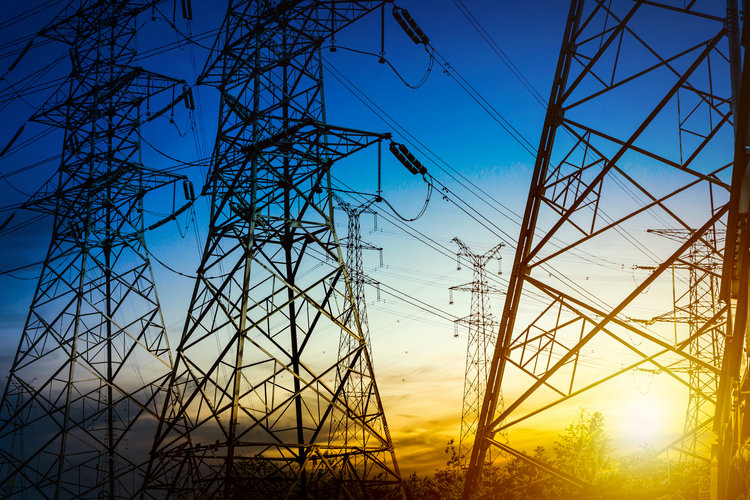
An ESA-backed project is harnessing satnav to insert an intelligent sense of place and time to power grids, to provide early warning of potentially dangerous electricity network failures.
Adding satnav to turn power grids into smart systems
6.5.2019 10:00
An ESA-backed project is harnessing satnav to insert an intelligent sense of place and time to power grids, to provide early warning of potentially dangerous electricity network failures.
Watch our Galileo smartphone app award and vote for your winner
12.4.2019 14:40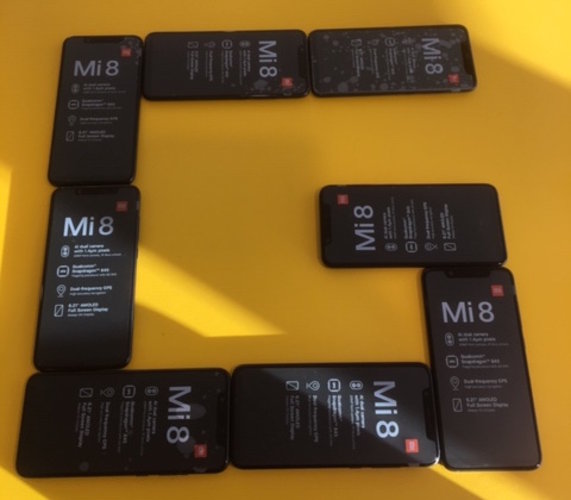
On Thursday 18 April, you are cordially invited to view the final presentations of ESA’s second Galileo smartphone app competition – to develop an app capable of performing fixes using raw Galileo satnav measurements – as well as put your own vote in for your favourite.
Watch our Galileo smartphone app award and vote for your winner
12.4.2019 14:40
On Thursday 18 April, you are cordially invited to view the final presentations of ESA’s second Galileo smartphone app competition – to develop an app capable of performing fixes using raw Galileo satnav measurements – as well as put your own vote in for your favourite.
ESA joins with business to invent the future of navigation
8.3.2019 16:57
The only thing more remarkable than how all of us are walking around with space-grade navigation capability and atomic clock timing precision in our pockets is how much we take all of this for granted. Satellite navigation has changed our lives, triggering a quiet revolution in our society and economy.
ESA joins with business to invent the future of navigation
8.3.2019 16:57
The only thing more remarkable than how all of us are walking around with space-grade navigation capability and atomic clock timing precision in our pockets is how much we take all of this for granted. Satellite navigation has changed our lives, triggering a quiet revolution in our society and economy.
ESA joins with business to invent the future of navigation
8.3.2019 16:57
The only thing more remarkable than how all of us are walking around with space-grade navigation capability and atomic clock timing precision in our pockets is how much we take all of this for granted. Satellite navigation has changed our lives, triggering a quiet revolution in our society and economy.
Four new Galileos join Europe’s largest satellite constellation
7.2.2019 15:16
The latest four Galileo satellites have been given the green light to begin working alongside the rest of Europe’s satellite navigation fleet, giving a further boost to worldwide Galileo service quality.
Four new Galileos join Europe’s largest satellite constellation
7.2.2019 15:16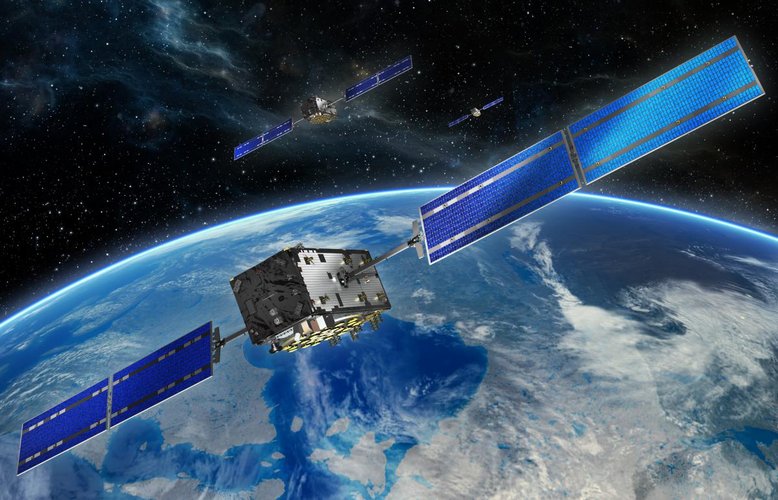
The latest four Galileo satellites have been given the green light to begin working alongside the rest of Europe’s satellite navigation fleet, giving a further boost to worldwide Galileo service quality.
Four new Galileos join Europe’s largest satellite constellation
7.2.2019 15:16
The latest four Galileo satellites have been given the green light to begin working alongside the rest of Europe’s satellite navigation fleet, giving a further boost to worldwide Galileo service quality.
Kite-blown Antarctic explorers make most southerly Galileo positioning fix
4.2.2019 8:12
A kite-blown science expedition to the interior of Antarctica has made the most southerly positioning fixes yet made with Europe’s Galileo satellite navigation system.
Kite-blown Antarctic explorers make most southerly Galileo positioning fix
4.2.2019 8:12
A kite-blown science expedition to the interior of Antarctica has made the most southerly positioning fixes yet made with Europe’s Galileo satellite navigation system.
NAVISP fostering technologies for Europe’s new age of navigation
31.1.2019 16:48
At ESA, the field of navigation covers more than just Galileo and satnav-sharpening EGNOS. More than a hundred European experts attended the inaugural NAVISP workshop at ESA’s technical heart, to discuss current R&D on a huge range of navigation-related topics, from driverless boats to intelligent power lines.
NAVISP fostering technologies for Europe’s new age of navigation
31.1.2019 16:48
At ESA, the field of navigation covers more than just Galileo and satnav-sharpening EGNOS. More than a hundred European experts attended the inaugural NAVISP workshop at ESA’s technical heart, to discuss current R&D on a huge range of navigation-related topics, from driverless boats to intelligent power lines.
NAVISP fostering technologies for Europe’s new age of navigation
31.1.2019 16:48
At ESA, the field of navigation covers more than just Galileo and satnav-sharpening EGNOS. More than a hundred European experts attended the inaugural NAVISP workshop at ESA’s technical heart, to discuss current R&D on a huge range of navigation-related topics, from driverless boats to intelligent power lines.
ESA sets clock by distant spinning stars
24.12.2018 9:00
ESA’s technical centre in the Netherlands has begun running a pulsar-based clock. The ‘PulChron’ system measures the passing of time using millisecond-frequency radio pulses from multiple fast-spinning neutron stars.
ESA sets clock by distant spinning stars
24.12.2018 9:00
ESA’s technical centre in the Netherlands has begun running a pulsar-based clock. The ‘PulChron’ system measures the passing of time using millisecond-frequency radio pulses from multiple fast-spinning neutron stars.
Galileo set to grow with global system update
21.12.2018 10:48
Having completed all necessary qualification testing, ESA has received the green light to upgrade the global infrastructure running Europe’s Galileo satellite navigation system. The resulting migration, set to start in February 2019, will incorporate new elements into the world-spanning system and boost the robustness of Galileo services delivered from the 26 satellites in orbit.
Galileo set to grow with global system update
21.12.2018 10:48
Having completed all necessary qualification testing, ESA has received the green light to upgrade the global infrastructure running Europe’s Galileo satellite navigation system. The resulting migration, set to start in February 2019, will incorporate new elements into the world-spanning system and boost the robustness of Galileo services delivered from the 26 satellites in orbit.
Contracts signed to make Galileo more robust and secure
20.12.2018 11:00
With 26 satellites in orbit and Initial Services available for two years, Europe’s Galileo satellite navigation system continues to evolve. Its latest onward step came this week, with contracts signed with Thales Alenia Space to strengthen Galileo’s global ground segment.
Contracts signed to make Galileo more robust and secure
20.12.2018 11:00
With 26 satellites in orbit and Initial Services available for two years, Europe’s Galileo satellite navigation system continues to evolve. Its latest onward step came this week, with contracts signed with Thales Alenia Space to strengthen Galileo’s global ground segment.
Galileo over Africa
17.12.2018 11:13
Space engineer Frank Bagiana took a smartphone equipped with the GalileoPVT app during his holiday to Africa to take augmented reality views of Galileo satellites in the sky
Galileo over Africa
17.12.2018 11:13
Space engineer Frank Bagiana took a smartphone equipped with the GalileoPVT app during his holiday to Africa to take augmented reality views of Galileo satellites in the sky
Galileo over Africa
17.12.2018 11:13
Space engineer Frank Bagiana took a smartphone equipped with the GalileoPVT app during his holiday to Africa to take augmented reality views of Galileo satellites in the sky
Galileo over Africa
17.12.2018 11:13
Space engineer Frank Bagiana took a smartphone equipped with the GalileoPVT app during his holiday to Africa to take augmented reality views of Galileo satellites in the sky
Gaming with Galileo: new Android smartphone apps published
17.12.2018 9:15
Use Europe’s satellite navigation system to seek treasure in virtual mazes or ‘see’ Galileos as they cross the sky above you: two new Android smartphone apps based on Galileo are now available for general download, the results of a competition by ESA trainees.
Galileo satellites prove Einstein's Relativity Theory to highest accuracy yet
4.12.2018 16:50
Europe’s Galileo satellite navigation system – already serving users globally – has now provided a historic service to the physics community worldwide, enabling the most accurate measurement ever made of how shifts in gravity alter the passing of time, a key element of Einstein’s Theory of General Relativity.
Join the future of navigation at ESA’s NAVISP Industry Days
29.11.2018 11:06
With 26 Galileo satellites in orbit around Earth, delivering services to users worldwide, what comes next? The ESA programme generating exciting new ideas for navigation technology is hosting its first Industry Days at the Agency’s technical heart in the new year – and companies from ESA Member States are invited to attend.
HAPS – missions to the edge of space to watch over Earth
15.11.2018 14:21
Is it a bird? Is it a plane? No, it’s a High-Altitude Pseudo-Satellite (HAPS) — an uncrewed airship, plane or balloon watching over Earth from the stratosphere. Operating like satellites but from closer to Earth, HAPS are the ‘missing link’ between drones flying close to Earth’s surface and satellites orbiting in space.
New ESA facility puts satnav at the service of science
9.11.2018 9:03
Global satellite navigation systems are continuously bathing Earth in satnav signals. As well as helping in our daily lives, these signals are also tools for cutting-edge science. A new ESA facility, based at ESA’s astronomy centre near Madrid, is championing their use for everything from Earth monitoring to fundamental physics.
Contract signing to boost performance and security of Galileo services
18.10.2018 9:15
Europe’s 26 navigation satellites in orbit are providing Galileo Initial Services – available to users around the globe since 2016 – and a new ESA contract signing means these services will be delivered on a more accurate basis and more securely than ever.
European students and researchers: compete in our new Galileo app competition
24.9.2018 13:11
Students and research trainees across Europe are invited to take part in ESA’s new Galileo smartphone app competition – to develop an app capable of performing fixes using raw Galileo satnav measurements.
Run by ESA in collaboration with the European Global Navigation Satellite Systems Agency – GSA – plus the European Commission with the support of Google, this Galileo app competition is open to all students from European universities and trainees in posts at European research and development organisations.
Android smartphone app connects you to Galileo
18.9.2018 14:08
An app that lets your smartphone work directly with Galileo and check performance from raw satellite signal measurements is now available for download from the Google Play Store.
Galileo’s ground control segment contracted for upgrade
6.9.2018 16:13With Europe’s Galileo constellation in space now expanded to 26 navigation satellites – and Galileo Initial Services available to users worldwide – the infrastructure on the ground that controls them is undergoing a corresponding expansion.
Precision EGNOS satnav sparking quiet revolution in aircraft landings
4.9.2018 15:13
If you’ve taken a flight in Europe recently, then the chances are growing that you’ve been a pioneer EGNOS user. Satellites in orbit would have guided your airliner’s descent, rather than signals beamed from the ground. You wouldn’t have felt any difference – except for possibly a smoother ride.
Galileo's road to space
25.7.2018 17:58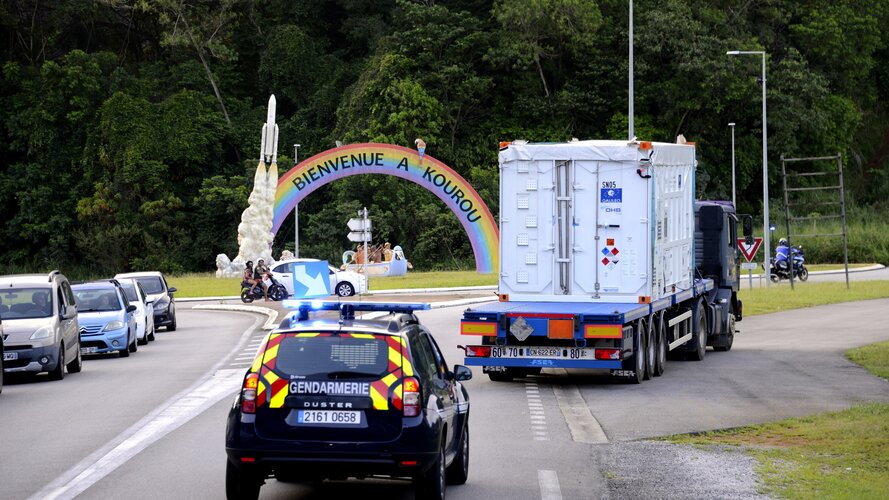
Video highlights of the launch campaign putting Galileo satellites 23–26 into orbit
Galileo's road to space
25.7.2018 17:58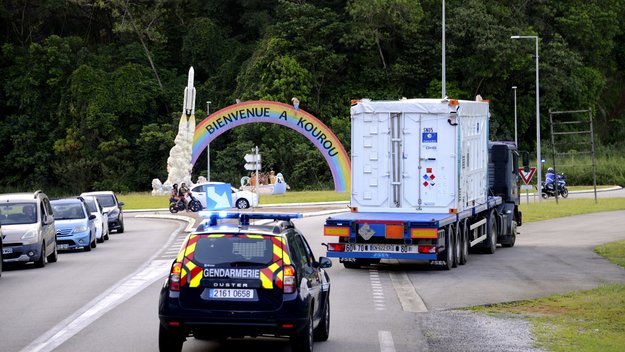
Video highlights of the launch campaign putting Galileo satellites 23–26 into orbit
New satellite launch extends Galileo’s global reach
25.7.2018 15:16
Four more Galileo satellites were launched today by an Ariane 5. Their arrival in orbit brings the Galileo constellation to 26 satellites, extending the global coverage of the constellation.
Galileo replay part 1
25.7.2018 14:18
Rewatch the full coverage of the liftoff and early ascent of Europe’s next four Galileo satellites 23–26
Galileo replay part 1
25.7.2018 14:18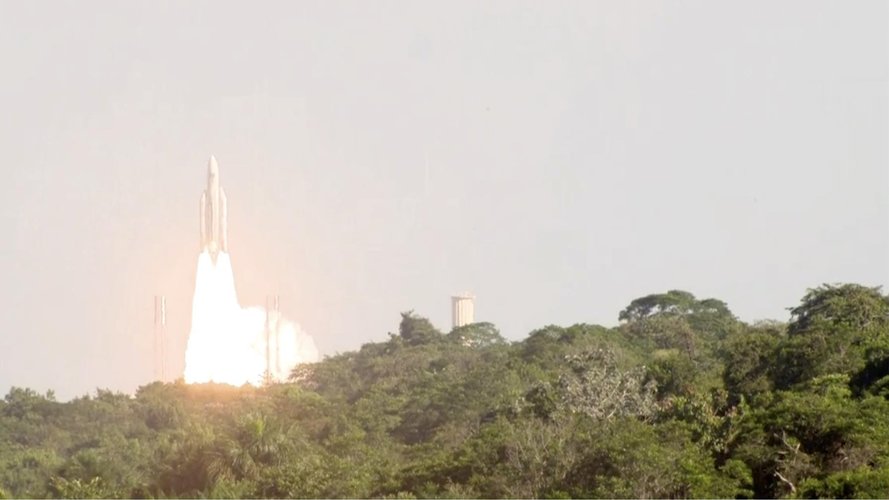
Rewatch the full coverage of the liftoff and early ascent of Europe’s next four Galileo satellites 23–26
Galileo liftoff replay
25.7.2018 12:50
Watch the replay of Europe’s next four Galileo satellites lifting off at 11:25 GMT (13:25 CEST, 08:25 local time) on Wednesday 25 July
Galileo liftoff replay
25.7.2018 12:50
Watch the replay of Europe’s next four Galileo satellites lifting off at 11:25 GMT (13:25 CEST, 08:25 local time) on Wednesday 25 July
Galileos at launch site
24.7.2018 9:47
The Ariane 5 carrying Galileo satellites 23-26 is in place at the ZL3 launch site ready for its liftoff tomorrow
Galileo’s next step
23.7.2018 14:03A new video gives the background to the launch of the next four Galileo satellites, the next step to expand Europe’s own satellite navigation system
Galileo’s next step
23.7.2018 14:03A new video gives the background to the launch of the next four Galileo satellites, the next step to expand Europe’s own satellite navigation system
Watch Galileo launch
23.7.2018 11:33
Follow the launch of Galileo satellites 19–22 live on Wednesday 25 July. Streaming starts at 11:00 GMT (13:00 CEST)
Watch Galileo launch
23.7.2018 11:33
Follow the launch of Galileo satellites 23-26 live on Wednesday 25 July. Streaming starts at 11:00 GMT (13:00 CEST)
Watch Galileo launch
23.7.2018 11:33
Follow the launch of Galileo satellites 23-26 live on Wednesday 25 July. Streaming resumes at 14:50 GMT (16:50 CEST)
Call for Media: Galileo 23-26 close to launch
17.7.2018 15:43
The last four Galileo satellites of the second FOC (Full Operational Capability) batch are scheduled for launch on 25 July at 11:25 GMT (13:25 CEST, 08:25 local time) from Europe’s Spaceport in Kourou, French Guiana, on an Ariane 5 rocket, designated Flight VA244 by Arianespace.
Galileo's fairing lowered
17.7.2018 9:27
The protective launch fairing for Galileos 23–26 is in place, ahead of their Wednesday 25 July 2018 launch
Europe’s next Galileo satellites in place atop Ariane 5
13.7.2018 10:42
Europe’s next Galileo satellites have been put in place on top of the Ariane 5 launcher due to lift them from Europe’s Spaceport in Kourou, French Guiana on Wednesday 25 July.
Galileos in the sky
11.7.2018 9:50
Technology image of the week: Galileo satellites ‘seen’ in augmented reality, using a new Galileo-focused smartphone app developed by ESA engineers
Galileos in place
9.7.2018 15:03
Attaching Europe's next Galileo navigation satellites to their dispenser ahead of their 25 July launch from Europe's Spaceport in French Guiana
Next four Galileo satellites fuelled for launch
3.7.2018 12:55
Europe’s next four Galileo satellites have been fuelled for launch at Europe’s Spaceport in Kourou, French Guiana, in preparation for their launch on 25 July.
Next four Galileo satellites fuelled for launch
3.7.2018 12:55
Europe’s next four Galileo satellites have been fuelled at Europe’s Spaceport in Kourou, French Guiana, in preparation for their launch on 25 July.
Combined orbital Galileo-GPS position fix achieved aboard ISS
2.7.2018 8:05
Europe’s satellite navigation system Galileo is already in use worldwide, usable by itself or in combination with the US Global Positioning System (GPS). Now a combined Galileo–GPS positioning fix has been achieved in space – aboard the International Space Station – through an ESA–NASA collaboration.
ESA trainees compete in inaugural Galileo app contest
15.6.2018 13:33
ESA challenged its young graduate and national trainees to develop a smartphone app to perform satnav fixes using only Galileo satellites. Three teams developed apps in their spare time, presenting their results to a jury of experts from ESA, the European Global Navigation Satellite Systems Agency (GSA) and Google.
Galileo, inside out
7.6.2018 16:30
Technology image of the week: an entire Galileo satellite was taken apart then put back together on this test bench for laboratory testing
Galileo, inside out
7.6.2018 16:30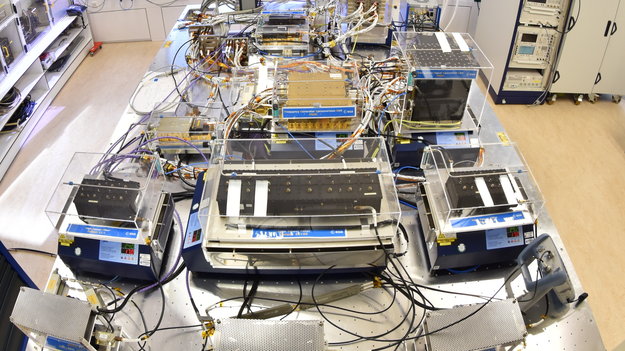
Technology image of the week: an entire Galileo satellite was taken apart then put back together on this test bench for laboratory testing
Galileo, inside out
7.6.2018 14:38
Technology image of the week: an entire Galileo satellite was taken apart then put back together on this test bench for laboratory testing
Next two Galileos plus launcher at Europe’s Spaceport for July launch
5.6.2018 13:08
Galileo satellites 25 and 26 have landed at Europe’s Spaceport in Kourou, French Guiana, joining their two predecessors ahead of their 25 July launch by Ariane 5.
Watch Galileo app contest
1.6.2018 9:25
ESA challenged its trainees to develop a smartphone app to perform Galileo-only satnav positioning. Watch the results today from 930 CEST
United Nations satnav specialists tour ESA’s technical heart
28.5.2018 11:16
Members of the United Nations technical group supporting global cooperation in satellite navigation toured ESA’s technical centre in the Netherlands, to see key facilities used to develop Europe’s Galileo system.
Unboxing Galileo
15.5.2018 14:04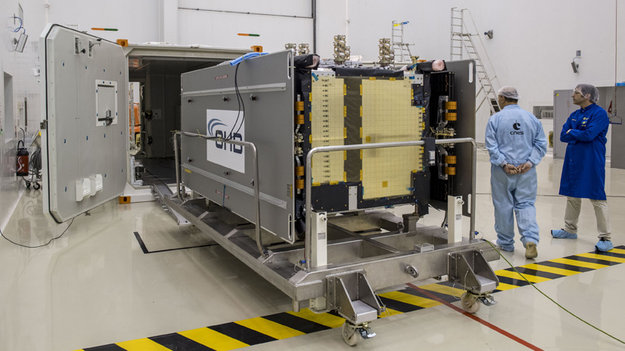
Galileo satellites 23 & 24 being unboxed in the Satellite Preparation Building after their 4 May 2018 arrival at Europe's Spaceport in Kourou, French Guiana
Satellite pair arrive for Galileo’s next rumble in the jungle
9.5.2018 9:37
The next two satellites in Europe’s Galileo satellite navigation system have arrived at Europe’s Spaceport in Kourou, French Guiana, ahead of their planned launch from the jungle space base in July.
Radio astronomers focus on ionosphere for sharper satellite navigation
13.4.2018 10:05
Radio astronomers and satellite navigation engineers are focusing their attention on the same point of the sky, looking into methods of improving both satnav accuracy and radio astronomy.
Navigate through satnav with the ESA–JRC Summer School
6.4.2018 10:16
This year’s ESA–Joint Research Centre International Summer School on Global Navigation Satellite Systems is taking place in July, in the spa resort of Loipersdorf, Austria.
The 10-day course will cover all aspects of satellite navigation, up to and including the development of a potential satnav-based business.
Participants will receive a full-spectrum overview of satellite navigation, starting from the theoretical basis of Global Navigation Satellite Systems, their signals and processing by receivers, and how the final ‘position–navigation–time’ solution is worked out. On the practical side, exercises will include receiving signals from Galileo and its fellow satnav systems.
World of Galileo
28.3.2018 15:30
Galileo’s initial services have been running for more than 15 months now: signals from the satellites in space are routinely serving users all across the world. The functioning of Galileo is dependent on a global network of ground stations, its current extent shown in the map here.
European industry has its say on Galileo’s post-2020 future
29.1.2018 13:31
With Europe’s Galileo satellite navigation system is only one launch away from full global coverage, representatives of European industry gathered at ESA’s centre in the Netherlands to discuss the transition towards the future Galileo Second Generation.
New technology version of EGNOS will harness Galileo for aviation
26.1.2018 12:55
The next generation of Europe’s satellite navigation overlay service, EGNOS, will combine use of GPS and Galileo signals to improve accuracy and robustness of navigation for air traffic and other uses where lives are at stake.
Galileo liftoff replay
13.12.2017 11:35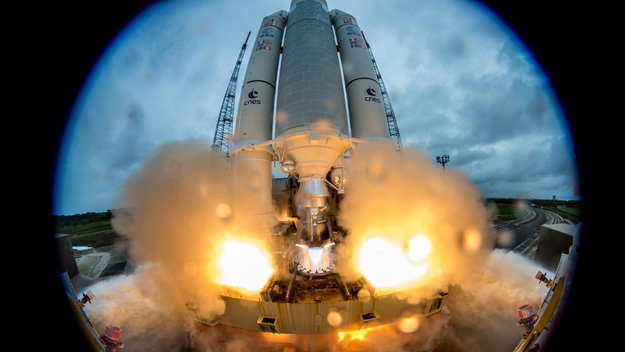
Rewatch the liftoff of Galileo satellites 19–22 by Ariane 5 from Europe's Spaceport in French Guiana on 12 December
Galileo launch brings navigation network close to completion
12.12.2017 23:22
Europe has four more Galileo navigation satellites in the sky following their launch on an Ariane 5 rocket. After today’s success, only one more launch remains before the Galileo constellation is complete and delivering global coverage.
Galileos in launch zone
12.12.2017 11:24
Galileos 19–22 rolled to their launch zone atop their Ariane 5 launcher during Monday afternoon, ready for today's launch
Galileo satellites atop rocket for next Tuesday’s flight
8.12.2017 14:10
Europe’s next four Galileo navigation satellites are in place atop their Ariane 5, ready to be launched next Tuesday.
Video: Galileos 19–22
5.12.2017 16:05
After a year of Galileo Initial Services, on 12 December an Ariane 5 will launch from Kourou with four new Galileo satellites, bringing the constellation a giant leap nearer completion
Call for Media: Galileo 19–22 ready for launch
5.12.2017 14:18
The next four Galileo satellites are scheduled for launch on 12 December at 18:36 GMT (19:36 CET, 15:36 local time) from Europe’s Spaceport in Kourou, French Guiana atop an Ariane 5 rocket.
Galileos on dispenser
4.12.2017 10:53
Europe's next four Galileo satellites 19–22 have met on their dispenser, then been transferred to the Final Assembly Building ahead of their Ariane 5 VA240 launch on 12 December
Galileos on dispenser
4.12.2017 10:53
Europe's next four Galileo satellites 19–22 have met on their dispenser, then been transferred to the Final Assembly Building ahead of their Ariane 5 VA240 launch on 12 December
Crossing drones with satellites: ESA eyes high-altitude aerial platforms
28.11.2017 10:37
ESA is considering extending its activities to a new region of the sky via a novel type of aerial vehicle, a ‘missing link’ between drones and satellites.
Galileo quartet fuelled and ready to fly
21.11.2017 16:05
Europe’s next four Galileo navigation satellites and the Ariane 5 rocket due to lift them into orbit are being readied for their 12 December launch from Europe’s Spaceport in Kourou, French Guiana.
Galileo in place for launch: then there were four
23.10.2017 16:20
Two more Galileo satellites have reached Europe’s Spaceport in French Guiana, joining the first pair of navigation satellites and the Ariane 5 rocket due to haul the quartet to orbit this December.
Galileo inside
18.10.2017 17:10
Technology image of the week: Europe’s Galileo satnav system at work on smartphones









